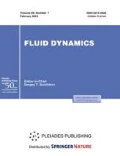Abstract—
The applicability of two-parameter turbulence models to investigation of the impact of free-stream high-intensity turbulence on the characteristics of near-wall flow and heat- and mass-transfer in the steady-state and unsteady boundary layers under the conditions of blowing and suction through permeable surface sections is analyzed. The calculated results obtained in specifying a constant relative mass flow rate parameter in the cases of blowing and suction through permeable sections are compared with the experimental data. The mechanisms of the interaction of blowing and suction of a gas of homogeneous constitution with the flow on two permeable sections upstream and downstream of these sections in the near-wall zone of turbulent boundary layer are studied on the basis of numerical solutions. The calculated results obtained in specifying a time-dependent flow-rate parameter on two permeable surface sections are given.








Similar content being viewed by others
REFERENCES
Simpson, R.L., The effect of a discontinuity in wall blowing on the turbulent incompressible boundary layer, Int. J. Heat and Mass Transfer, 1971, vol. 14, no. 12, pp. 2083–2097.
Simpson, R.L., Characteristics of turbulent boundary layers at low Reynolds numbers with and without transpiration, J. Fluid Mech., 1970, vol. 42, Pt. 4, pp. 783–799.
Kays, W.M., Heat transfer to the transpired turbulent boundary layer, Int. J. Heat Mass Transfer, 1972, vol. 15, no. 5, pp. 1023–1044.
Andersen, P.S., Kays, W.M., and Moffat, R.J., Experimental results for the transpired turbulent boundary layer in an adverse pressure gradient, J. Fluid Mech., 1975., vol. 69, pt. 2, pp. 353–375.
Aleksin, V.A. and Sovershennyi, V.D., Numerical calculation of a turbulent boundary layer with a sharp change in the boundary conditions, in: Turbulentnye techeniya (Turbulent Flows), pp. 55–63, Moscow: Nauka, 1977.
Aleksin, V.A., Sovershennyi, V.D., and Chikova, S.P., Calculation of the turbulent boundary layer at surfaces with porous sections, Fluid Dynamics, 1978, vol. 13, no. 1, pp. 51–57.
Lapin, Yu.V., Turbulentnyi pogranichnyi sloi v sverkhzvukovykh potokakh gaza (Turbulent Boundary Layer in Supersonic Gas Flows), Moscow: Nauka, 1970.
Leont’yev, A.I., Lushchik, V.G., and Yakubenko, A.E., Compressible turbulent boundary layer on a permeable plate on injection of extraneous gas, Teplofiz. Vysok. Temp., 2007, vol. 45, no. 4, pp. 543–551.
Din, Q.H., Egorov, I.V., and Fedorov, A.V., Mach wave effect on laminar–turbulent transition in supersonic flow over a flat plate, Fluid Dynamics, 2018, vol. 53, no. 5, pp. 690–701.
Aleksin, V.A., Numerical simulation of the interaction of unsteady surface blowing (suction) with turbulent near-wall flow, Fluid Dynamics, 2019, vol. 54, no. 6, pp. 797–811.
Savill, A.M. (Ed.), Transition Modelling for Turbomachinery II: An Updated Summ. of ERCOFTAC Trans. SIG Progr. 2nd WORKSHOP. Cambridge: Univ. Press, 1994.
Epik E.Ya. Heat transfer effects in transitions, in: Proc. on Turbulent Heat Transfer, Engineering Foundation Conf. N.Y.: San Diego California, 1996, pp. 1–47.
Aleksin, V.A. and Kazeykin, S.N., Modeling the effect of freestream turbulence on unsteady boundary layer flow, Fluid Dynamics, 2000, vol. 35, no. 6, pp. 846–857.
Aleksin, V.A., Simulation of the effect of the freestream turbulence parameters on heat transfer in an unsteady boundary layer, Fluid Dynamics, 2003, vol. 38, no. 2, pp. 237–249.
Ginevskii, A.S., Ioselevich, V.A., Kolesnikov, A.V., Lapin, Yu.V., Pilipenko, V.A., and Sekundov, A.N., Methods of calculating the turbulent boundary layer, in: Advances in Science and Engineering. Fluid Mechanics, vol. 11, pp. 155–304, Moscow: VINITI, 1978.
Hanjalic, K. and Launder, B.E., Contribution towards a Reynolds-stress closure for low-Reynolds-number turbulence, J. Fluid Mech., 1976, vol. 74, no. 4, pp. 593–610.
Bradshaw, P., Ferris, D.H., and Atwell, N.P., Calculation of boundary layer development using the turbulent energy equation, J. Fluid Mech., 1967, vol. 28, no. 3, pp. 593–616.
Lushchik, V.G., Pavel’ev, A.A., and Yakubenko, A.E., Three-parameter model of turbulence: Heat transfer calculations, Fluid Dynamics, 1986, vol. 21, no. 2, pp. 200–211.
Leont’ev, A.I., Lushchik, V.G., and Makarova, M.S., Temperature recovery factor in the boundary layer on a permeable plate, Teplofiz. Vysok. Temp., 2017, vol. 55, no. 2, pp. 255–261.
Jones, W.P. and Launder, B.E., The calculation of low-Reynolds-number phenomena with a two-equation model of turbulence, Int. J. Heat and Mass Transfer, 1973, vol. 16, no. 6. pp. 1119–1130.
Chien, K.-Y., Predictions of channel and boundary-layer flows with a low-Reynolds-number turbulence model, AIAA J., 1982, vol. 20, no. 1, pp. 33–38.
Aleksin, V.A., Modelling of the interaction of unsteady high-intensity turbulence flow with heat- and mass-transfer in the boundary layer on the surface, Fluid Dynamics, 2018, vol. 53, no. 6, pp. 774–785. https://doi.org/10.1134/S0015462818060137
Funding
The investigation was carried out in accordance with the theme of the State Program no. АААА-А20-120011690135-5 and under a partial support from the Russian Foundation for Basic Research (project no. 20-01-00162).
Author information
Authors and Affiliations
Corresponding author
Additional information
Translated by E.A. Pushkar
Rights and permissions
About this article
Cite this article
Aleksin, V.A. Applicability of Two-Parameter Turbulence Models to Simulation of the Interaction of Near-Wall Flows with Blowing and Suction on Permeable Surfaces. Fluid Dyn 55, 778–792 (2020). https://doi.org/10.1134/S0015462820060026
Received:
Revised:
Accepted:
Published:
Issue Date:
DOI: https://doi.org/10.1134/S0015462820060026


